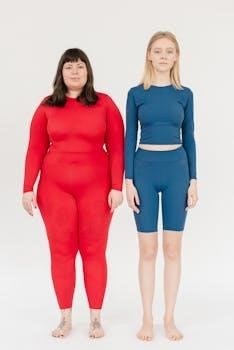Navigating the world of womenswear sizing can feel overwhelming․ This guide provides essential tools to help you find the perfect fit‚ covering international conversions‚ measurements‚ and size charts․
Womenswear sizing can often feel like a complex puzzle‚ varying significantly across brands and even within the same brand’s different styles․ Unlike standardized measurements‚ clothing sizes are more of a guideline‚ influenced by factors such as target demographic‚ design aesthetics‚ and manufacturing processes․ This guide aims to demystify the process‚ providing you with the knowledge and tools necessary to confidently navigate the world of women’s clothing sizes․ We’ll explore the intricacies of international size conversions‚ offering a clear understanding of how sizes translate between US‚ UK‚ EU‚ and other systems․ Additionally‚ we’ll delve into the importance of accurate body measurements‚ teaching you how to take precise bust‚ waist‚ and hip measurements to ensure a proper fit․ Furthermore‚ we’ll provide detailed size charts for various clothing types․

Understanding International Size Conversions
Shopping across borders requires understanding different sizing systems․ This section provides clear conversions between US‚ UK‚ EU‚ and French sizes‚ helping you confidently choose the correct size internationally․
US to UK Size Conversion
Understanding the conversion between US and UK women’s clothing sizes is crucial for online shopping and international travel․ Generally‚ US sizes are smaller than UK sizes․ For instance‚ a US size 0 is typically equivalent to a UK size 4․ This difference of four sizes generally holds true across the sizing spectrum‚ but it’s always wise to consult a specific size chart․
Remember that these conversions are approximate guidelines․ Different brands may have slight variations in their sizing․ Checking the brand’s size chart is best practice before making a purchase․ When in doubt‚ consider measuring yourself and comparing your measurements to the brand’s size chart․
To convert from US to UK‚ add 4 to your US size․ Thus‚ a US size 2 equates to a UK size 6․
EU to US Size Conversion
Converting between European (EU) and United States (US) women’s clothing sizes is important for international purchases․ EU sizes generally run larger than US sizes․ A US size 0 typically corresponds to an EU size 30 or 32‚ depending on the brand and style․ It is recommended to always consult a specific size chart․
To convert from EU to US sizes‚ subtract approximately 30 from the EU size․ However‚ keep in mind that this is a general rule‚ and slight variations can occur across different brands․
Checking a brand-specific size chart before ordering is essential to ensure the best fit․ Discrepancies can exist‚ making direct conversions unreliable․ When possible‚ measure yourself and compare those measurements to the chart provided by the retailer․ Accurate measurements help avoid returns and ensure satisfaction․
French Size Considerations
French clothing sizes can be a bit tricky to navigate‚ as they differ significantly from US and UK sizes․ Generally‚ French sizes are close to EU sizes‚ but it is not always a perfect match․ Therefore‚ understanding the nuances of French sizing is crucial for online shopping and international purchases․
To convert from US to French sizes‚ add approximately 32 to your US size․ For example‚ a US size 2 would roughly translate to a French size 34․ This is merely a guideline‚ and variations can occur between brands․
French sizes are also used in Belgium‚ Spain‚ and Portugal‚ so this conversion knowledge can be useful when shopping in those countries․ Always refer to the brand’s specific size chart‚ as there may be subtle differences․ Taking accurate body measurements is essential for ensuring the correct fit․

Taking Accurate Body Measurements
Accurate body measurements are crucial for finding clothes that fit well․ Use a flexible measuring tape and follow our guide to measure your bust‚ waist‚ and hips correctly․
Bust Measurement
To measure your bust accurately‚ wear a non-padded bra that fits well․ Stand straight with your arms relaxed at your sides․ Take the measuring tape and wrap it around your back‚ under your arms‚ and across the fullest part of your bust․ Ensure the tape is level all the way around your body․
The tape should be snug but not too tight‚ allowing you to breathe comfortably․ Note the measurement where the tape meets‚ making sure it’s in inches or centimeters‚ depending on the size chart you are using․ It’s helpful to have someone assist you to ensure the tape remains level and accurate․ This measurement is vital for determining the correct size for tops‚ dresses‚ and jackets․
Remember that bust size can fluctuate slightly due to factors like time of month‚ so it’s a good idea to measure yourself periodically for the most accurate fit․
Waist Measurement
To obtain an accurate waist measurement‚ stand naturally and locate your natural waistline․ This is typically the narrowest part of your torso‚ usually just above your belly button․ It’s important not to suck in your stomach or flex your muscles‚ as this will distort the measurement․
Wrap the measuring tape around your waist‚ ensuring it is parallel to the floor․ The tape should be snug but not too tight; you should be able to comfortably slide a finger underneath․ Note the measurement where the tape meets․ This measurement is crucial for determining the size of skirts‚ trousers‚ and dresses that cinch at the waist․
For the most precise reading‚ use a flexible measuring tape and have someone else assist you․ Remember that your waist size can vary slightly depending on posture and time of day‚ so taking multiple measurements can help ensure accuracy․
Hip Measurement
Measuring your hips accurately is essential for finding well-fitting bottoms like skirts‚ trousers‚ and dresses․ Stand with your feet together and ensure you’re on a level surface․ Locate the fullest part of your hips‚ typically around 8 inches (20 cm) below your natural waistline․
Wrap the measuring tape around the fullest part of your hips‚ ensuring the tape remains parallel to the floor․ The tape should be snug but not too tight; you should be able to slide a finger comfortably underneath․ It’s crucial that the tape measures around the widest circumference of your hips and buttocks․
Record the measurement where the tape meets․ If you find it difficult to measure yourself accurately‚ ask a friend to assist you․ Take multiple measurements to ensure consistency‚ and use the largest measurement for size selection․ Accurate hip measurements are key to avoiding garments that are too tight or too loose․

Size Charts by Clothing Type
Clothing sizes vary across garment types․ Find specific size charts for tops‚ dresses‚ and bottoms to ensure the best fit․ Each chart provides detailed measurements tailored to each style․
Tops and Blouses Size Chart
When selecting tops and blouses‚ understanding size charts is crucial for achieving a comfortable and flattering fit․ These charts generally incorporate bust‚ waist‚ and sometimes shoulder measurements to guide your choice․ Brands often have slight variations‚ so always refer to the specific size chart provided by the retailer or manufacturer․
Typically‚ you’ll find sizes ranging from XS to XXXL‚ or numerical sizes like 0‚ 2‚ 4‚ and so on․ Compare your body measurements to the chart’s measurements to identify your corresponding size․
Consider the style of the top as well; a fitted blouse may require a different size than a loose-fitting tunic․ If your measurements fall between sizes‚ it’s often recommended to choose the larger size for comfort‚ especially for bust measurements․ Always double-check before finalizing your purchase․
Dresses and Jumpsuits Size Chart
Finding the right size for dresses and jumpsuits involves considering multiple measurements․ Size charts for these garments usually include bust‚ waist‚ and hip measurements‚ ensuring a proper fit through the torso and hips․ Similar to tops‚ sizes are typically represented numerically or alphabetically (XS-XXXL)․
When consulting the size chart‚ prioritize the bust and hip measurements for dresses‚ and the torso length for jumpsuits․ Keep in mind that the style of the dress or jumpsuit—whether it’s fitted‚ A-line‚ or flowy—can affect the ideal size․
Always check the brand’s specific size chart‚ as variations occur․ If your measurements fall between sizes‚ choosing the larger size is often recommended‚ especially if the garment is fitted․ Remember to consider the fabric; some materials may have less give than others․
Bottoms (Skirts and Trousers) Size Chart
Selecting the correct size for skirts and trousers hinges primarily on your waist and hip measurements․ Size charts for bottoms usually provide these measurements in inches or centimeters‚ corresponding to standard sizes ranging from US 0 to US 20 (or XS to XXL)․
For skirts‚ the hip measurement is crucial‚ especially for fitted styles‚ while the waist measurement determines the fit at the natural waistline․ Trousers require both waist and hip measurements to ensure a comfortable and flattering fit through the seat and thighs․
Inseam length is another important factor‚ particularly for trousers‚ determining where the hem falls on your leg․ Brands often offer different inseam lengths (e․g․‚ regular‚ long‚ petite) to accommodate varying heights․ Always consult the brand’s specific size chart‚ as sizing can differ significantly․ If you are between sizes‚ consider the style and fabric; stretchier fabrics may allow for a smaller size․

Factors Affecting Size Variations
Womenswear sizing isn’t standardized‚ leading to variations․ Brand differences‚ fabric types‚ and style influence how a garment fits․ Understanding these factors is key to making informed purchasing decisions․
Brand-Specific Sizing Differences
One of the most frustrating aspects of womenswear shopping is the inconsistency in sizing across different brands; A size 6 at one retailer might fit completely differently than a size 6 at another․ This phenomenon‚ known as “vanity sizing‚” contributes to the confusion․ Some brands may cater to a specific body type‚ resulting in variations in measurements․
Luxury brands often have sizing that runs smaller compared to fast-fashion retailers․ Understanding the sizing tendencies of your favorite brands can significantly improve your online shopping experience․ Always consult the specific size chart provided by the brand‚ if available․ Don’t rely solely on your usual size‚ as it can vary greatly․ Customer reviews can also offer valuable insights into a brand’s sizing accuracy․ Remember‚ a little research can save you time and ensure a better fit․
Impact of Fabric and Style on Fit
The type of fabric and the style of a garment significantly influence how it fits․ Stretch fabrics‚ such as knits and elastane blends‚ offer more flexibility and a closer fit‚ often accommodating a wider range of body shapes․ Woven fabrics‚ like cotton or linen‚ typically have less give and may require a more precise fit․
The style of the garment also plays a crucial role․ A-line dresses‚ for example‚ tend to be more forgiving than bodycon dresses․ Similarly‚ loose-fitting blouses will fit differently than tailored shirts․ Consider the intended silhouette of the garment and how it will drape on your body․ If you’re between sizes‚ consider the fabric and style․ Size down for stretchy materials and looser styles‚ and size up for rigid fabrics and fitted designs․ Paying attention to these details will increase the likelihood of finding clothes that not only fit well but also flatter your figure․

No Responses